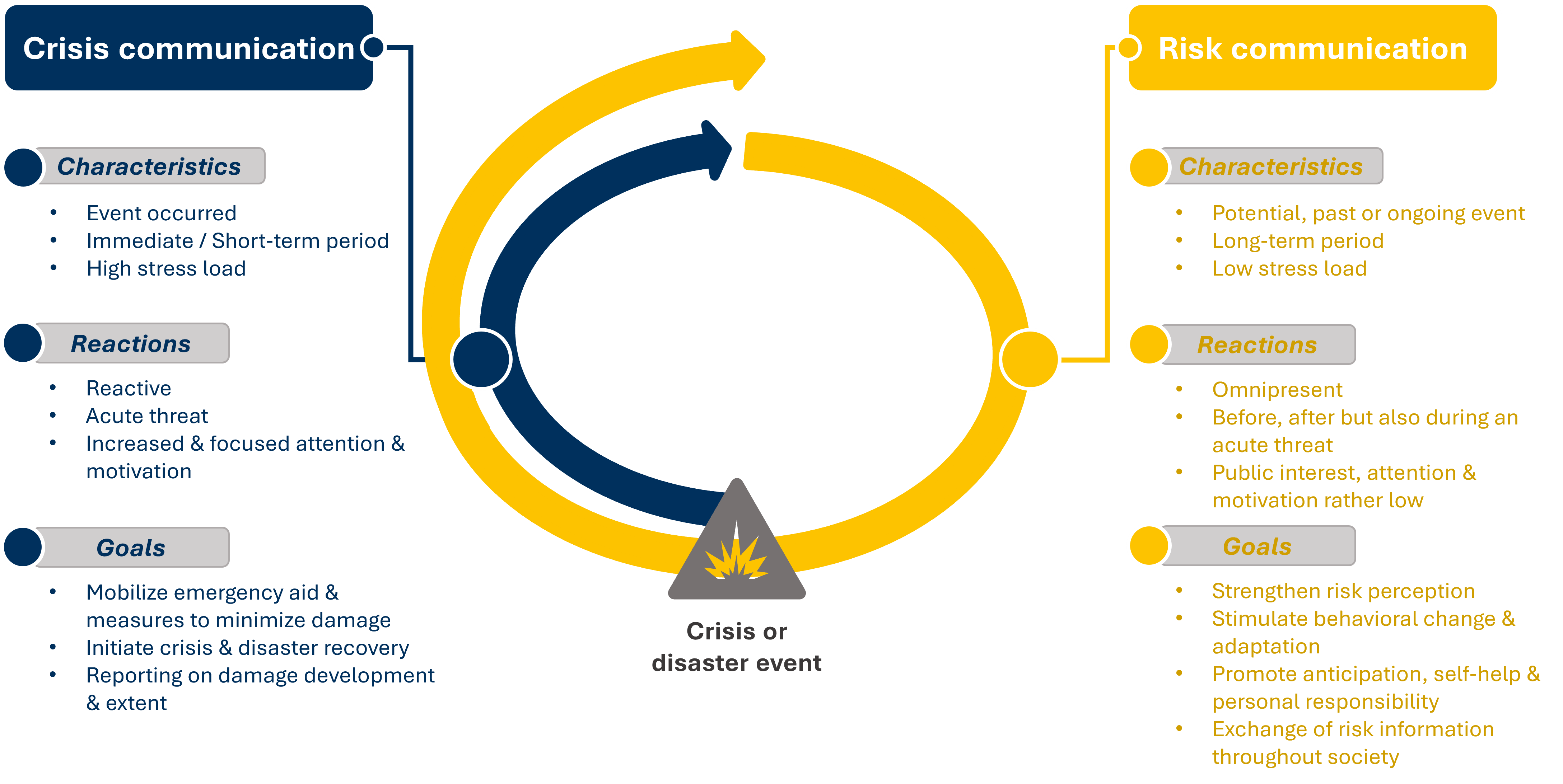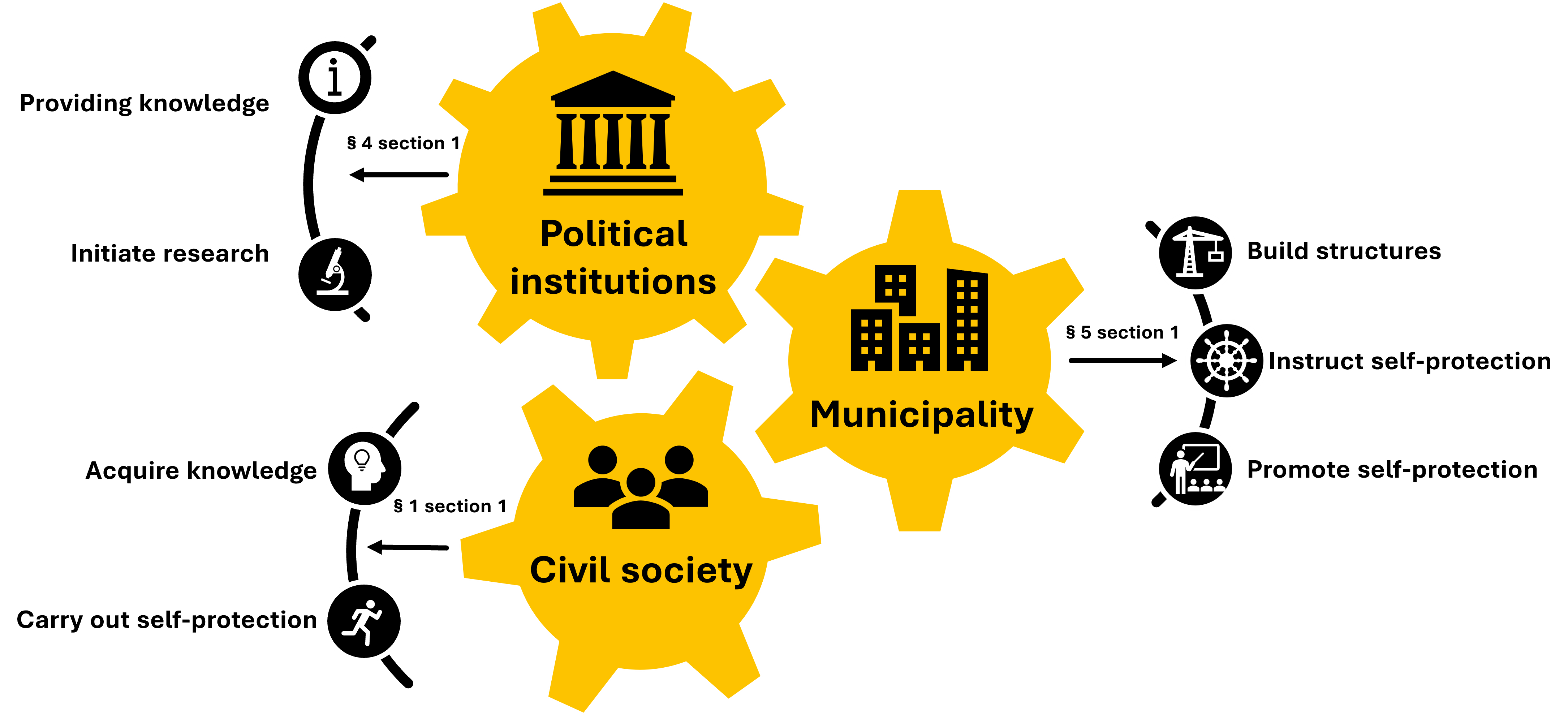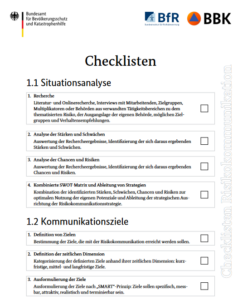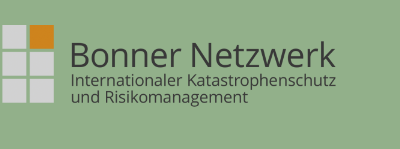Risk communication
Risk communication is a term that is used in many different contexts. But what function does risk communication fulfill in the context of disaster prevention? Get a deeper insight into the role of risk communication for society as well as its limitations and challenges, on this topic page.
© changed to Pixabay
Introduction
What we know about the world, we know through communication. Communication creates the foundation, the basis of all our actions. Based on this communicatively generated background, information is conveyed: if you don’t already know what a storm is, you can’t really do anything with a warning about gusts of wind. Anyone talking about communication must always consider both: the background required to understand the information and the information itself that is to be communicated.
When acute danger is imminent, information must be communicated in a way that it is being understood – but understanding does not simply mean hearing, seeing, reading, and receiving, but interpreting information against the background of one’s own experience and drawing the “right” conclusions for the situation. Interpreting means to assign information to the background that has already been created through past communication. When acute danger is imminent, there is no time to create the interpretive framework needed to understadn information correctly. This must therefore be done in advance: By means of risk communication.
This topic page provides an insight into the key aspects of risk communication in the context of disaster prevention.
What is risk communication?
In disaster risk reduction, the term risk communication refers to all communicative activities that take place in the run-up to a potential crisis or disast (BBK, 2022). It is a central element of the management of risks and their control and deals, for example, with probabilities of occurrence and the potential extent of damage caused by risks (Renner & Gamp, 2014). The focus of risk communication is on the “exchange of information and opinions on risk avoidance, minimization and acceptance” (BBK, 2022, S. 17).
Fig. 1: Classification of risk and crisis communication in disaster risk management. Own illustration based on Renner & Gamp, 2014
While communication in disasters or crises is short-term – time is always too short in this context – and therefore only allows for limited background information, risk communication creates the background for a holisitc understanding (Voss & Lorenz, 2016). “It explains and also has the time to illustrate contradictions and uncertainties and put them up for discussion within society” (Dickmann, 2014, S. 94). Risk communication thus creates the conditions for successful crisis communication. At the same time, lessons should be learned from the experiences of situations that have been overcome and risk communication should be continuously improved as a result. However, since society is always changing anyway, risk communication is never static. This is why a textbook cannot adequately provide factual guidance for good risk communication in the context of the respective social conditions. Instead, risk communication is much more to be understood as a very demanding process. The Federal Office of Civil Protection and Disaster Assistance (BBK) speaks of an integrative communication strategy that should help to ensure that risk and crisis communication works better after each event than before (BBK, 2022, S.29f).
Risk and crisis communication are closely intertwined (see Fig. 1) and must therefore be viewed in conjunction with each other. However, even if the two differ in terms of various characteristics, responses and objectives, they must not be separated from each other as a natural cycle due to the occurrence of a catastrophic event, as is often depicted in graphics. This would ignore the fact that risk and crisis communication often take place at the same time and is therefore misleading. Rather, the interplay of joined risk and crisis communication helps to strengthen the resilience of society as a whole through an ongoing learning process (visualised by the break out of the circle).
Legal foundations
The Law about the civil protection and disaster management of the Federation (ZSKG) is of central importance for the legal basis of risk communication in Germany. The ZSKG clarifies the federal government’s legal obligation to inform the population about risks, protection and supply measures. It also stipulates that the responsibilities of the state, local authorities and the population are subsidiary to self-protection in the context of risk communication. The following diagram shows which responsibilities are assigned to which actors (BBK, 2022, S. 11ff).
Fig. 2: Responsibilities within risk communication on a legal basis; own illustration based on BGBI, 2020
Classification in the understanding of risk communication
The state and public administration are therefore legally obliged to provide information to the population (BBK, 2022, p. 11). However, the state should not merely provide information; rather, it is also dependent on information from the population. The widespread idea that knowledge and information must flow linearly from state actors to information recipients no longer has anything to do with the reality of today’s communication complexities. More realistic is the idea that a wide variety of communication channels and formats as well as a multitude of voices influence the perception of a potential risk. Good risk communication should aim to steer this complex communication process in a constructive, risk-minimizing direction.
The role of risk communication
Risk communication therefore describes the exchange and discussion of relevant information on risk avoidance, minimization and acceptance (BBK, 2022, p. 17). The willingness of scientists, practitioners, the state and civil society to actively participate in this process is crucial for the development of a risk culture. Today, risks can be determined less than ever in purely technical and mathematical terms; rather, they arise from the interaction of very different dynamics and are assessed differently by the stakeholders. Risk communication must therefore be understood as a multidimensional process in which all those potentially affected by the risks should be involved, which entails a variety of challenges.
A communicatively generated risk culture provides the perceptual framework against which risks are identified and assessed. The fact that communication creates this framework of perception should not be understood in purely linguistic terms. All events are also perceived through communication. People do not simply observe, but interpret against the background of the knowledge they have acquired through communication and discuss events with others. Risk perception is therefore always influenced by one’s own experiences or observations and for this reason is also strongly influenced by events in the recent past and the form of perceived media reporting. The current state of risk perception in science, practice, the state and civil society is therefore also the result of previous communicative processes, which are significantly influenced by the authorities and organizations with security tasks (BOS). Although all social stakeholders should ultimately be actively involved in this process, the overarching responsibility lies with the BOS.
Risk perception is both the basis and the goal of risk communication. The current state of risk perception in science, practice, the state and civil society reveals how active the exchange of risk information is and determines where municipal or state support is needed to stimulate this discourse. At the same time, these measures aim to strengthen risk perception in the future. This is because risk perception plays a key role in determining whether a society is resilient to a wide range of hazards and it´s scope of awareness and willingness to adapt to those risks (BBK, 2022, p. 18ff).
Practical approaches to risk communication
What is understood by the term risk communication according to the current state of discussion has been described in detail above. In the following section, the focus will be led on the practice of risk communication.
The Federal Office of Civil Protection and Disaster Assistance (BBK) provides key principles for risk communication for practical implementation in the publication “Risk Communication – A Handbook for Practice (2022)” (only available in german). Even if different communication strategies are pursued depending on the context of application, overarching principles can be formulated that are relevant across all areas: (BBK, 2022, p. 24ff).
1. Proactive communication
- Not reactive to requests or on the occasion of current disasters/crises.
- Instead, early and continuous communication.
2. Comprehensive transfer of information
- Risk communication must be up-to-date, appropriate and complete.
- Explains the short and long-term effects, origins and developments.
3. Openness and transparency
- Transparent risk communication requires disclosure of scientific uncertainties.
- Explanation of causes and estimates of uncertainties in risk assessment.
- Promoting understanding of scientific uncertainties as part of communication strategies.
4. Comprehensibility
- Technical terms should be explained or replaced by easy-to-understand language.
- Risk information should be presented graphically.
- Risk communication should be close to everyday life (e.g. in the sense of a field report) and therefore short and concise.
5. Trust and confidence
- Trust is the most important foundation of successful risk communication.
- Trust arises from transparency and openness.
- Information should therefore be provided as transparently as possible.
6. Target group specific
- Risk communication should be appealing to the respective target group in terms of content and media.
- Risk communication should be linked to specific recommendations for action.
7. Exchange
- Exchange/discussion uncovers grievances, need for adaptation, wishes and special features.
- Exchange must be participatory.
BBK/BfR: Risk communication checklist
The Federal Office of Civil Protection and Disaster Relief (BBK) and the Germand Federal Institute for Risk Assessment (BfR) have drawn up a checklist (only available in german) based on various process-oriented conceptual models from the field of public relations (cf. Schmidbauer & Knödler-Bunte 2004; Dörrbecker & Fissenewert-Goßmann 1997) in order to adequately transfer the principles of successful risk communication into practice:
Media channels and players in risk communication
For risk communication, not only processes and content are decisive, but also by whom and via which means of communication risk information is passed on. Both aspects are closely linked.
Even if risk information is mostly communicated to the public, the structure of risk communication does not provide for a static direction of communication. The focus is on the “exchange of information and opinions” (BBK, 2022, p. 17).
Even if risk communication does not always involve all stakeholders, it is considered fundamental that all collected findings are made publicly accessible in order to enable public discourse and that information that is also required to identify and assess risks, if not yet available, is generated, e.g. by means of research. This structure is in contrast to crisis communication, which is more focused on the transmission of information for time-critical reasons. (Renner & Gamp, 2014)

Fig. 3: Overview of actors involved in risk communication; own illustration based on Dickmann 2021
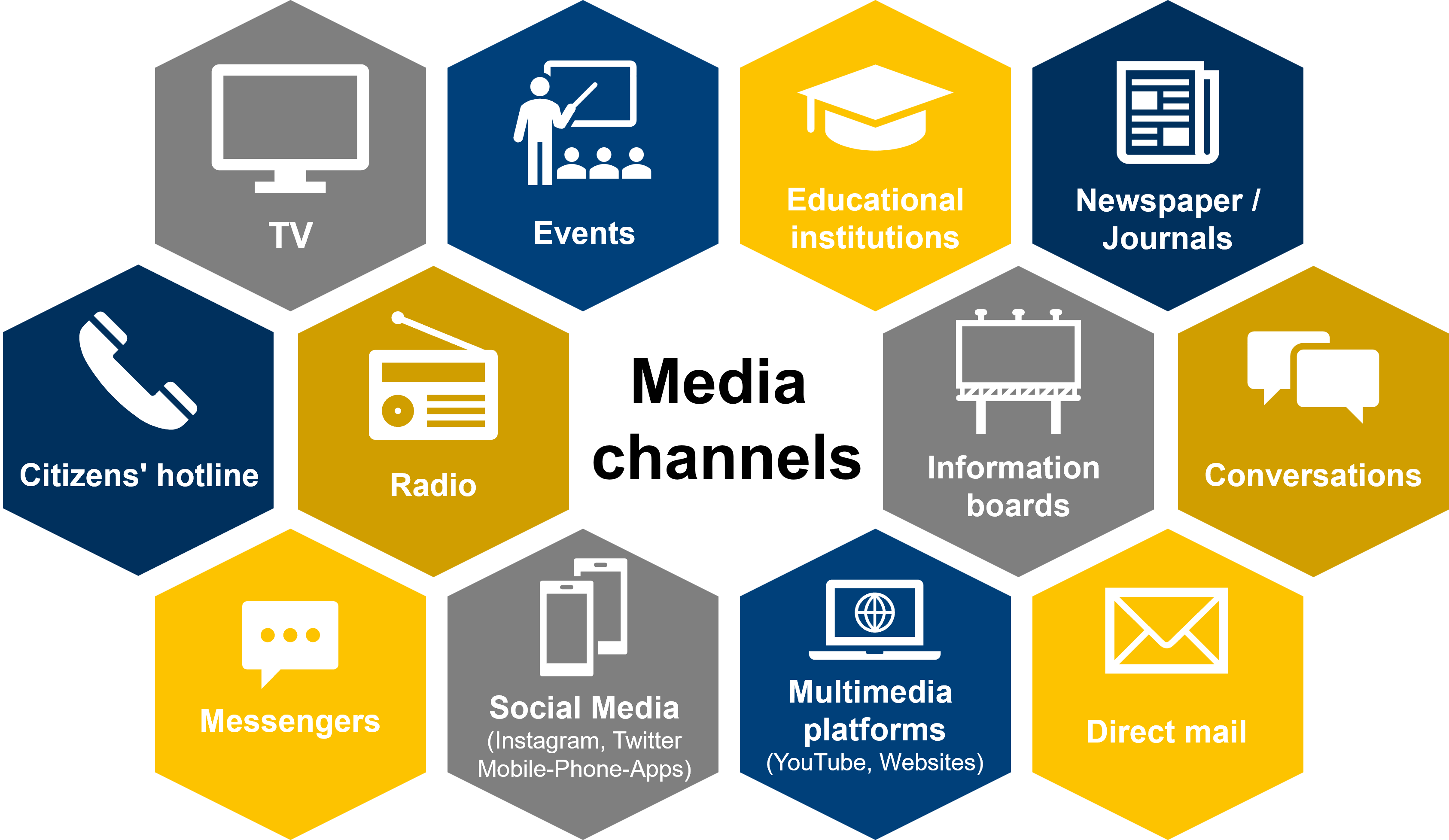
Fig. 4: Selection of media channels for risk communication; own illustration based on BBK, 2022, p. 90
Fake news or facts
The corona pandemic triggered fear and uncertainty; the infection dynamics, unstructured processes, improvised behavior, lack of expertise in the complex interrelationships of a pandemic, etc. created a suitable breeding ground for conspiracy myths and false reports ( see e.g. Rocha, Y.M., de Moura, G.A., Desidério, G.A. et al., 2023). Through social media, false reports spread quickly and make it difficult for users to distinguish them from scientifically generated information, i.e. information backed up by institutionalized quality controls. Even former US President Trump suggested in April 2020 that people should try injecting disinfectants containing harmful and carcinogenic substances against the coronavirus (Rohwedder, 2020). Trump’s statement led to a significant increase in calls to poison hotlines and several deaths.
A study by the Neu-Ulm University of Applied Sciences also shows how important it is for the population to be able to critically examine the truthfulness of risk information. Its results reveal that knowledge-based and credible risk information in the context of the pandemic increases the willingness to accept a vaccination and thus also the risk awareness of the population (Schöberl, S. & Kieweg, P. 2022, p. 1).
As part of the target group-specific orientation of risk communication, the choice of appropriate media instruments is essential. In addition to comprehensibility and interest in risk information, communication must also be tailored to the media behavior and media presence of the stakeholders (Potnis, 2015 and Bharadwaj und Khan, 2016).
In numerous studies, researchers have looked at which media different target groups use to absorb and search for risk-relevant information. The following figure shows a selection of communication channels through which actors from the state, science, practice and civil society exchange risk information. Digital means of communication are becoming increasingly dominant. Due to their permanent availability, practically any person is able to actively influence risk communication at any time and can circulate fake news (Schulz & Neelsen, 2019).
Challenges of risk communication
Communicating risk information to the public poses various challenges for different stakeholders. A variety of factors play a role here: (incorrect) assumptions about how people behave when confronted with risk information shape the behavior of many stakeholders, not only, but especially in the BOS. For example, information is sometimes not communicated because it is feared that it would unsettle people. However, social science research has shown for many decades that people are primarily unsettled by the fact that information is withheld from them, whereas deviant social behavior (such as violence, looting, endangering oneself or others, etc.) due to information – if it occurs at all – is the absolute exception (see Lorenz, Schulze, Voss 2018).
An important role in risk communication is played by the caution of state representatives not to cast doubt on the state’s promise of protection. In other words, the state does not like to show what it cannot do or what it lacks in order to provide assistance in crises and disasters, while it can never guarantee absolute protection. However, there are also high demands at a very specific level: no handbook can tell you when what needs to be communicated to whom and how. The respective form of communication plays just as an important role as the choice of media or the differentiated knowledge of the reception behavior of different social milieus.
Lessons-Learned & Lessons to Learn
Communicating risk information to the population in such a way that increased risk perception and resilience, can be assumed in the long term to pose various challenges for different stakeholders. Not only does information have to be credibly transferred in line with the spread of fake news, but the information providers are also required to adapt their communication to the media behavior and information needs of their recipients. This involves overcoming linguistic, social and many other barriers (Reeh, 2019).
Risk communication has been the subject of social science research for decades. Numerous international research projects are also looking into the question of what factors constitute good or necessary risk communication and how the communication of risks can be improved.
Numerous lessons learned and best practices were collected and processed as part of the DKKV Risk Communication & Prevention project. A detailed results report is currently being prepared and will be published shortly.
Virtual reality glasses from the "RIKOST" research project
360-degree photos that show passers-by in 8 Tyrolean pilot municipalities the local hazard zone maps and existing natural hazards in an interactive and tangible way.
Find out more (Link).
Tools to promote community participation in the "NET RISK WORK" research project
Through community-building activities, people should be brought into safe contact with various natural hazards. For example, a photo competition in the forest to raise awareness of vegetation fires.
Find out more (Link).
SERIOUS GAMES
Serious games pursue the concept of conveying serious content on, for instance, the effects of various natural hazards on people, the environment, and infrastructure in a playful way, thus actively promoting risk communication.
Find out more on our topic page on Serious Games.
Created: March 2024
Current Information
DKKV says goodbye to Durga Mohanakrishnan
DKKV says goodbye to Durga Mohanakrishnan after one year of collaboration. As a fellow of the Alexander von Humboldt Foundation, she worked on the project "Disaster risk communication & preparedness of communities" between October 2022 and September 2023,...
New date for the 2nd workshop of the “RisiK Communication” Working Group
The second workshop on risk communication, organised by the working group "Risk Communication" of the Bonn Netwerk International Civil Protection and Disaster Risk Reduction, will take place on 3 August 2023 from 15:00 to 17:00 in the DKKV meeting room in Bonn. The...
Halftime Conference for German Chancellor Fellowship 2022/2023
The Halftime Conference for German Chancellor Fellows 2022-24 was a five-day event held at Merseburg from April 24th to April 29th, 2023. The main objective of the program was to provide an opportunity for the fellows and hosts to come together and intensify their...



